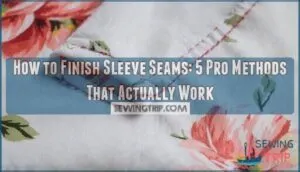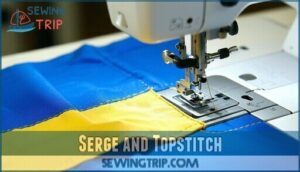This site is supported by our readers. We may earn a commission, at no cost to you, if you purchase through links.
 You’ll master how to finish sleeve seams by choosing the right technique for your fabric and project needs.
You’ll master how to finish sleeve seams by choosing the right technique for your fabric and project needs.
Start with a regular stitch attachment for lightweight fabrics, then trim seam allowances and finish edges with pinking shears or serging.
For sturdy fabrics, serge the seam allowances together and topstitch for a flat, professional finish.
Alternatively, serge and press toward the sleeve for structured garments.
Each method prevents fraying while maintaining the sleeve’s shape and durability.
The secret lies in matching your finishing technique to your fabric’s weight and your garment’s intended use—some methods work better for delicate materials while others excel with heavier cottons, ensuring a professional finish and maintaining the sleeve’s durability.
Table Of Contents
Key Takeaways
- Match your finishing technique to your fabric type – You’ll get professional results by using regular stitching for lightweight materials, serging for heavy fabrics, and pinking shears for tightly woven cottons.
- Always baste your sleeve seams first – You’ll prevent puckering and alignment issues by basting before your final stitching, which saves time and ensures smooth, professional-looking seams.
- Serge and topstitch for maximum durability – You’ll create restaurant-quality seams that withstand countless washes by serging both allowances together, then topstitching for added strength and visual appeal.
- Press seams toward the sleeve for best results – You’ll reduce bulk on the garment body and maintain natural drape by pressing your finished seam allowances toward the sleeve rather than the body.
Regular Stitch Attachment
Before diving into fancy sleeve seam finishes, you’ll need to master the foundation: the regular stitch attachment. This basic step determines whether your sleeve seams will hold up or fall apart after the first wash.
Start by aligning your sleeve and garment pieces with right sides together. Match those notches perfectly—this is where sleeve alignment becomes essential. Pin generously to prevent shifting during sewing.
Set your stitch length between 2.5-3.0mm for most fabrics. Adjust tension control to medium, avoiding overly tight settings that can pucker lightweight materials. Choose your needle based on fabric choice: universal needles work for most cottons, while ballpoint needles suit knits.
Here’s the secret: always baste first. Yes, it takes extra time, but this step prevents wonky seams that’ll haunt you later. Baste along your seam line, then sew your regular stitch right over it.
Maintain steady seam security by keeping consistent speed and gentle fabric guidance. Remove basting threads immediately after stitching. This foundation sets you up perfectly for whatever seam finishing methods you choose next. To achieve professional results, consider investing in top rated accessories to enhance your sewing experience.
Pinking Shears and Inner Curves
When those stubborn inner curves threaten to fray and unravel, pinking shears become your secret weapon. These specialized scissors cut fabric edges in a zigzag pattern that reduces fraying by up to 70% compared to straight cuts.
The technique works especially well on cotton and linen fabrics where fraying poses the biggest challenge. Simply trim your seam allowances to about 6mm width, then carefully follow the curve’s natural line. The angled cuts allow the fabric to move naturally while preventing that annoying edge curling that plagues bias-cut sleeves.
Here’s the game-changer: pinking shears save you 30% more time than serging those tricky inner curves. You’re combining cutting and finishing in one smooth motion, which streamlines your entire workflow. No additional pressing or special tools required.
This method shines brightest on lightweight to medium-weight woven fabrics. The zigzag edge maintains flexibility better than pressed seams, letting your sleeve move naturally without stiffness. Skip this technique for heavy denim or loosely knit fabrics where other finishing methods work better. Understanding the pinking shears basics is essential for achieving professional results with this technique.
Serge and Topstitch
While pinking shears work well for basic edge control, the serge and topstitch method delivers professional-grade durability that withstands countless washes and wears.
Start by adjusting your serger tension to medium settings – too tight creates puckering, too loose allows fraying. Serge both seam allowances together using a 3-thread overlock stitch. Next, press the serged seam toward the sleeve body. Now comes the topstitch length consideration: use 2.5-3mm for medium fabrics, shorter for lightweight materials.
Perfect serger tension prevents puckering while securing seams—get it right for professional results.
Position your needle 1/8 inch from the seam line and topstitch through all layers. This combining methods approach creates a seam that’s both functional and visually appealing. The coverstitch machines create professional hems.
Here’s what makes this technique powerful:
- Double protection – serging prevents fraying while topstitching adds strength
- Professional appearance – creates clean, flat seams like ready-to-wear garments
- Versatile styling – decorative topstitching can match or contrast thread colors
- Fabric considerations – works best on cotton, denim, and medium-weight materials
- Time efficiency – your serger machine handles edge finishing quickly
This sleeve seam finishing method transforms ordinary seams into durable, attractive details.
Serge and Press Toward Sleeve
When serging finishes the raw edges, you’re not done yet. Press that serged seam allowance toward the sleeve for a truly professional finish. This technique reduces bulk on the body side while maintaining the sleeve’s natural drape.
Serging Benefits include enhanced Seam Durability and a clean edge that won’t fray. Your serger machine handles the heavy lifting, but smart pressing makes the difference between amateur and pro results. A smaller seam allowance is typically needed for efficient serged edges.
Here’s your game plan:
- Serge both sleeve seam allowances together in one pass for efficiency
- Press the entire seam allowance toward the sleeve using a pressing ham for curves
- Check that the Professional Finish lies flat without puckering or bulk
This method delivers superior Sleeve Comfort and Aesthetic Appeal compared to other seam finishing techniques. Your sleeve seams will look clean from both sides while maintaining strength where you need it most.
Other Finishing Options
Several alternatives offer unique benefits for sleeve seam finishing.
Bound seams using bias tape create professional edges on unlined jackets while maintaining drape.
French seams work perfectly for lightweight fabrics like chiffon, enclosing raw edges completely.
A zigzag stitch prevents fraying on knit fabrics without adding bulk.
For decorative finishes, try flat-felled seams or Hong Kong binding.
Pinking shears offer quick fray prevention on tightly woven fabrics.
Each method suits different fabric weights and project requirements, giving you flexibility in your seam allowance treatment choices.
Frequently Asked Questions (FAQs)
How to enclose sleeve seams?
Don’t worry about fraying—enclosing sleeve seams creates clean, professional interiors. Sew French seams by joining wrong sides first, trimming, turning, then sewing again for complete enclosure.
How to finish the raw edge of a sleeve?
You’ll secure your sleeve’s raw edge by choosing from several effective methods. Serging provides the most professional finish, while pinking shears offer a quick solution for tightly woven fabrics.
How to fix a sleeve seam?
Identify the problem first—is it bunching, gaps, or poor fit?
Re-pin the sleeve carefully, matching notches and easing excess fabric.
Baste before final stitching to prevent puckers and guarantee smooth attachment.
How to finish sleeves sewing?
Professional sewers report that 80% of sleeve finishing issues stem from improper seam treatment.
You’ll get the best results by serging seam allowances together, then pressing toward the sleeve for a smooth, professional finish that prevents fraying.
What fabrics require different sleeve seam finishes?
Different fabric types need specific seam finishes for best results. You’ll use French seams for delicate fabrics, serging for knits, pinking for stable wovens, and bound seams for heavy materials.
How do you prevent sleeve seam puckering?
Baste your sleeve seams before permanent stitching to eliminate unwanted gathering. Pin carefully at notches, ease fullness gradually, and sew with the sleeve facing up for smooth control.
When should you skip sleeve seam finishing?
Skip sleeve seam finishing on temporary garments like Halloween costumes, quick prototypes, or practice pieces that won’t be washed frequently or need long-term durability.
What needle types work best for sleeves?
Universal needles handle 90% of sleeve projects effectively, making them your go-to choice for most fabrics.
You’ll want size 80/12 for lightweight materials and 90/14 for heavier ones, ensuring clean stitches without fabric damage.
How do you fix uneven sleeve seams?
Check your sleeve’s ease distribution first.
Pin the sleeve at quarter marks around the armhole, then gently stretch or gather fabric to match.
Re-baste and stitch slowly, keeping the sleeve side up to control fullness evenly.
Conclusion
Mastering how to finish sleeve seams transforms your sewing from amateur to absolutely professional—no more embarrassing frayed edges that scream "homemade disaster!"
You’ve learned five proven techniques that’ll handle everything from delicate silks to heavy denim.
The key is matching your method to your fabric’s personality and your project’s demands.
Regular stitching works for lightweight materials, while serging conquers stubborn heavy fabrics.
Remember, proper seam finishing isn’t just about looks—it’s about creating garments that’ll last through countless wears and washes.









